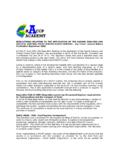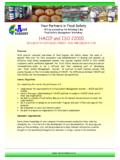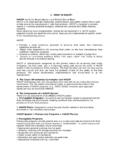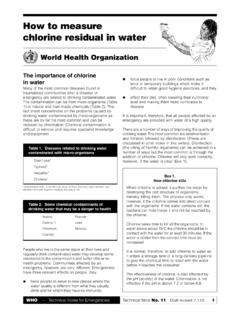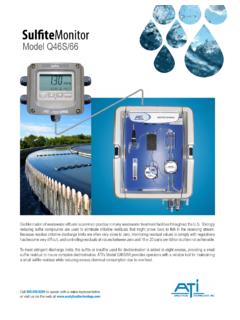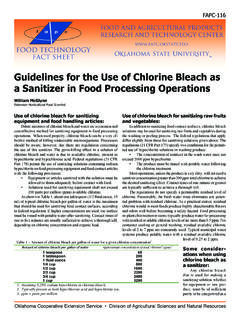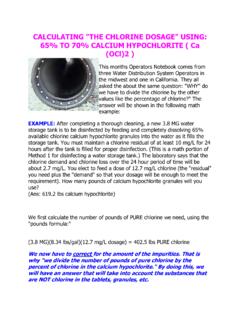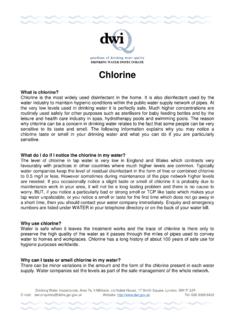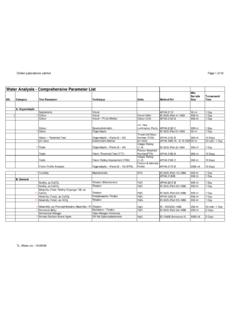Transcription of Use of Chlorine in the Food Industry - HACCP Academy
1 Use of Chlorine in the food Industry Chlorine compounds are widely used in the food Industry to kill bacteria and disinfect. Examples include treating pasteurizer cooling water, washing fruit and vegetables and disinfecting food contact surfaces. Chlorine is usually combined with inorganic compounds, such as sodium or calcium, to produce hypochlorites, which are effective disinfectants. Chlorine mixed with sodium is a liquid bleach1 known as sodium hypochlorite NaOCl. Chlorine mixed with calcium is usually in granular or tablet form and is called calcium hypochlorite - Ca(OCL)2. Chlorine may also be available as Chlorine dioxide (ClO2).
2 However, hypochlorites are the most active of the Chlorine compounds. Table 1 lists these and other common Chlorine sanitizer compounds. Table 1. Common Chlorine sanitizer compounds Chemical Synonyms sodium hypochlorite ~5% active hypochlorous acid, sodium oxychloride, Chlorine bleach sodium hypochlorite ~10-15% active hypochlorous acid, sodium oxychloride Chlorine calcium hypochlorite hypochlorous acid, calcium oxychloride sodium dichloroisocyanurate Dichloro-s-triazine-2,4,6-trione; sodium salt Chlorine dioxide Chlorine oxide, Chlorine peroxide sodium chlorite none Factors affecting Chlorine efficacy Certain factors can affect the sanitizing power of Chlorine compounds.
3 They include the presence of organic material, pH, temperature, concentration, and contact time. When using Chlorine as a sanitizer, note the following: 1. Presence of organic material. Organic material such as food residues decreases the effect of Chlorine . For proper disinfection, use Chlorine on cleaned surfaces only. Make sure you remove all organic material residue including fat and protein, before you apply Chlorine as a sanitizer. 2. The pH of a Chlorine solution. The level affects the antimicrobial activity. Use Chlorine solutions with a pH range of to for optimum antimicrobial activity. At pH values near , hypochlorite solutions are most effective, but very unstable.
4 At high pH values, the efficacy of Chlorine is reduced. If you are using a highly alkaline cleaner to remove protein and fat residues, rinse the surfaces thoroughly before applying Chlorine solution because high pH residues will reduce the Chlorine activity. 3. Temperature. Generally, Chlorine antimicrobial activity increases with warmer temperatures. However, at high temperatures, Chlorine compounds may release Chlorine gas which is toxic. The potential of corrosion also increases as temperatures go up. 4. Concentration. Higher concentration of Chlorine increases the effectiveness of killing micro organisms.
5 However, high concentrations of Chlorine are not recommended because they can cause corrosion, explosions, and adversely affect the health of workers. A Chlorine concentration of 50 to 200 parts per million (ppm) is recommended to disinfect food contact surfaces including utensils, equipment, and tables. 5. Contact time. The bactericidal activity increases with longer exposure time. If the Chlorine solution you are using does not exceed 200 ppm, no rinsing of the surface is required. If using a solution stronger than 200 ppm, rinse the surface with clean water after a few minutes of application. Do not let the Chlorine solution stay in contact with equipment for more than 30 minutes or it could corrode.
6 Storage of Chlorine Aqueous Chlorine solutions such as commercial household bleaches are not stable. This means that Chlorine may dissipate rapidly, reducing its content and effectiveness. So, Chlorine powders should be used to sanitize in food processing plants, not bottled bleach. Preparing a Chlorine solution Hypochlorite liquid solutions commonly used in the food Industry can be diluted with water until they reach the right concentration desired. Example To prepare 100 litres of a 50 ppm solution from a per cent sodium hypochlorite (NaOCl), the following calculations are needed: Final Chlorine solution volume = 100 litres = 100,000 millilitres (ml), because a litre = one thousand millilitres Final Chlorine solution concentration desired = 50 ppm Initial Chlorine solution concentration = solution = 125,000/1,000,000 which can also be expressed as 125,000 parts per million (ppm) because 1 ppm = 1 ml in 1,000,000 ml Initial Chlorine solution volume = Z.
7 Initial Chlorine x Initial Chlorine = Final Chlorine x Final Chlorine solution solution solution solution concentration volume volume concentration desired 125,000 ppm x Z = 100,000 ml x 50 ppm Z = 40 ml To prepare 100 litres of a 50 ppm solution of sodium hypochlorite, dilute 40 ml of a sodium hypochlorite solution with water. Monitoring your Chlorine solution Once you prepare your Chlorine solution, use a test kit to monitor free available Chlorine and in some cases, total residual Chlorine (TRC) concentrations. Free available Chlorine refers to the amount of Chlorine available to react with bacteria.
8 TRC is the amount of Chlorine in the water, which includes Chlorine available and Chlorine bound with organic materials. Free and total residual Chlorine test kits are commercially available including test strips, color cubes, titration-based test kits, colorimeters and colour discs. ---------------------------------------- ---------------------------------------- ---------------------------------------- ------------ Nitrates and Nitrites in Meat Products Nitrates and nitrites are used widely in the meat Industry to cure. They are usually mixed with meat binders and cure ingredients and are added to dry sausages, semi-dry sausages, preserved meat and preserved meat by-products such as ham and salami.
9 They can be added in the form of sodium and potassium salts (eg: sodium nitrate, sodium nitrite, potassium nitrate and potassium nitrite). Use Nitrates and nitrites are used to: control the growth of spores provide cured meat flavour and colour extend the shelf life of meat products Control the growth of spores Nitrates/nitrites control the growth of spores, particularly from Clostridium botulinum. These spores are a real concern in the food Industry , because they can survive normal heat processing. Under the right conditions, they can produce vegetative cells, which can create a lethal toxin. Influence on colour Nitrites cause a colour reaction in the meat and add an appealing pink colour to cooked products.
10 Meat products without nitrates/nitrites are brown or gray coloured. Nitrates undergo a chemical reaction and are converted to nitrites. Then, nitrites react with the protein of the meat (myoglobin), and are converted to nitrosomyoglobin (bright red). When cooked, nitrosomyoglobin is converted to nitrosohemochrome (pink pigment). This bright pink colour is normally associated with cured meat such as wieners, bologna and ham. Why are nitrates/nitrites regulated in South Africa? The use of nitrates or nitrites is restricted because high levels can be hazardous to humans. Excess nitrates can react with amino acids in proteins during processing and form carcinogenic nitrosamines.
